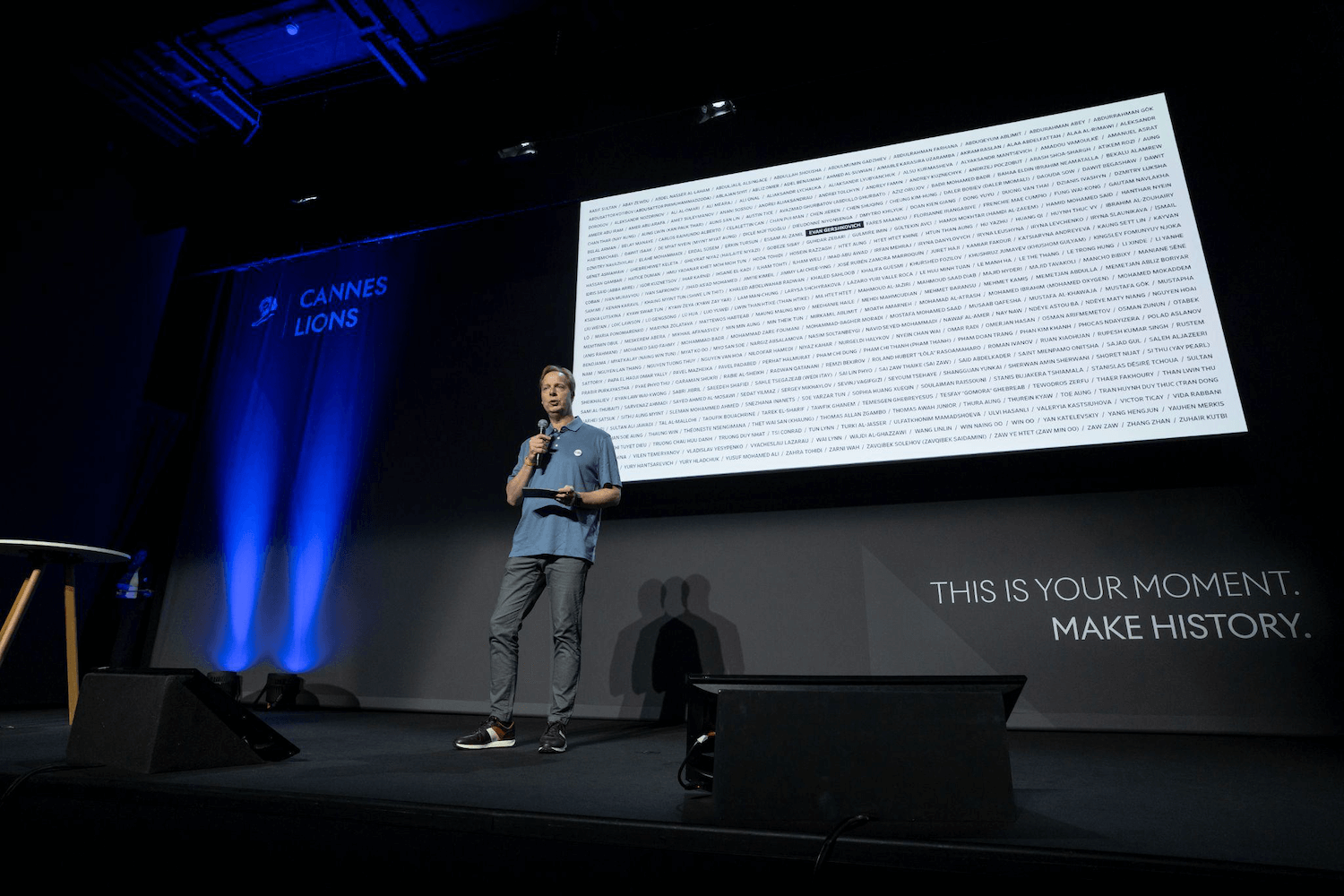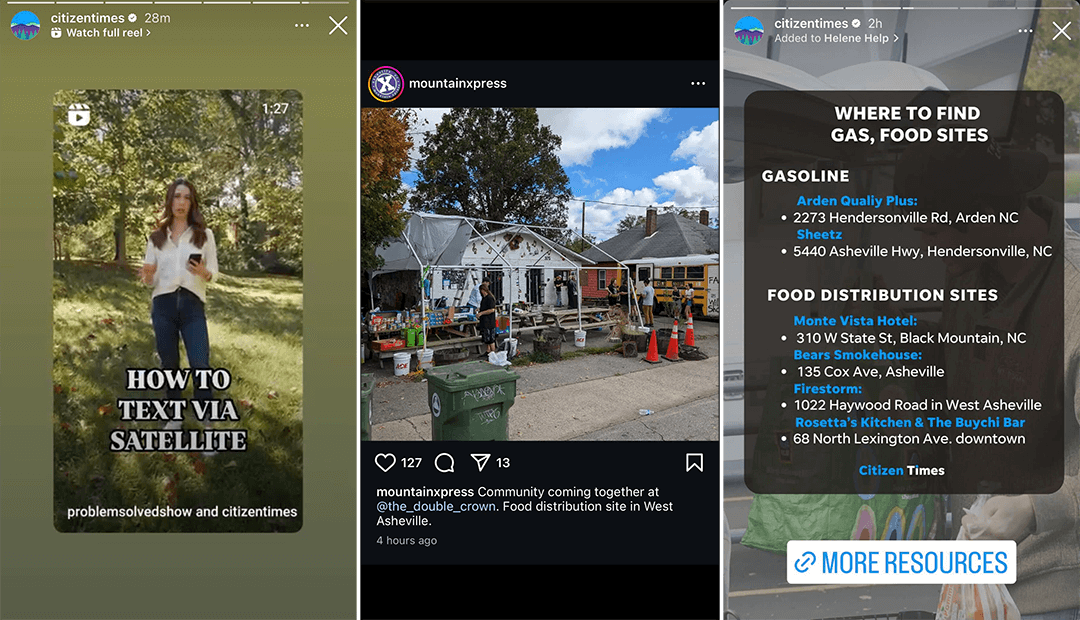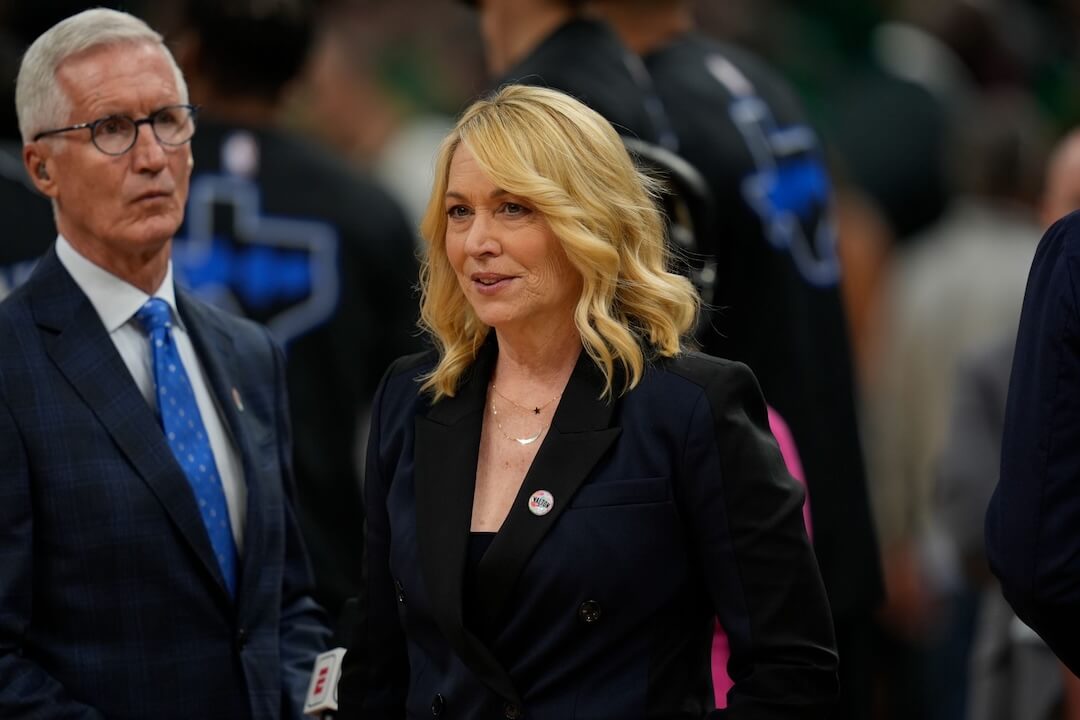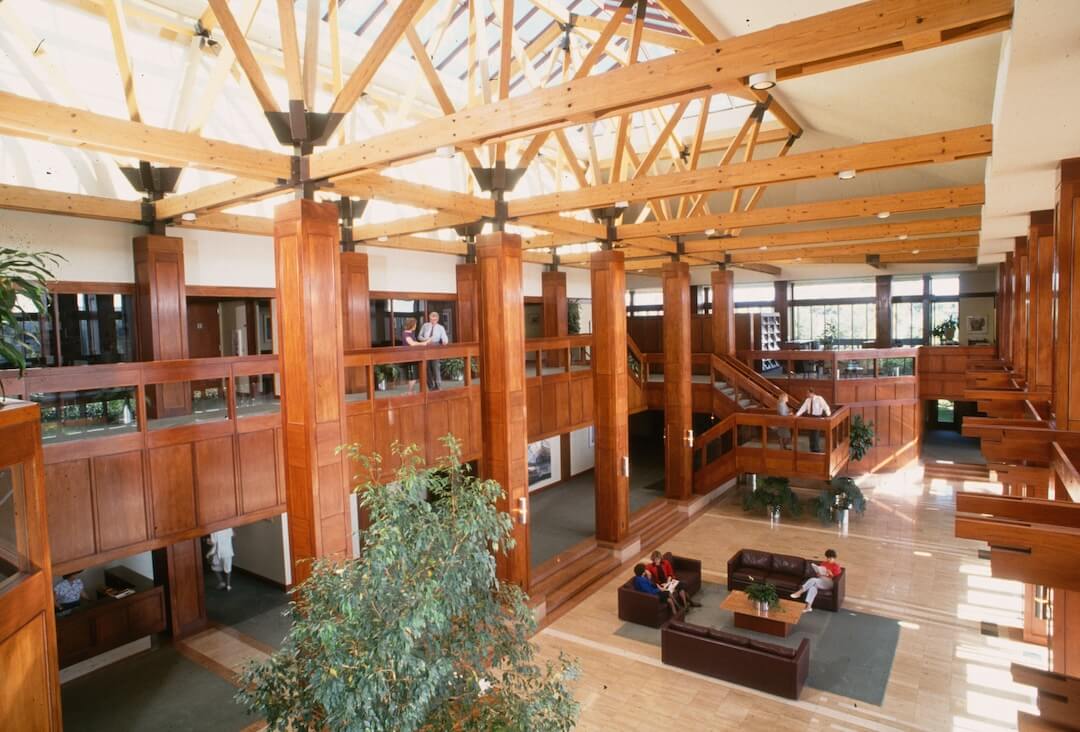Neighbors, neighborhood, safe, text, call and data.
I feel like I’ve used these words more in the last week than in my entire life.
Friday morning, Sept. 27, Hurricane Helene hit our mountainside home in Asheville, North Carolina. I woke my wife up around 5 a.m. and told her to get the dog and go to the basement. Moments later, we heard trees falling all around.
By 10 a.m., the worst had passed and, miraculously, our home and lives were safe.
By habit, I grabbed my phone. I still had two LTE bars. I called my parents to let them know I was safe. I couldn’t get through, but a text did. My family knew I was OK even as the storm was still passing over.
So down the mountain I went to check on my neighbors. Trees, power lines and debris covered the road. There are about 45 homes on our mountain, several had trees on their roofs. By 11 a.m., everyone had been accounted for and was safe.
The rain had stopped, the wind died down. I was the only person with cell coverage. A few people got word out they were safe.
Around noon, I was trying to share what little was being reported. My data was there, but slow. Then my LTE icon disappeared and SOS replaced it.
That was the last time I was able to use my phone until Sunday night at 10:39 p.m.
We were going to sleep on Sunday night when our phones started pinging on our nightstands. I immediately called my mom. That was the first time in three days she heard my voice or knew I was safe.
We all cried.
Two things happened during the time I had no service.
The first was that I grabbed my chainsaw and headed down the mountain. All day Friday, Saturday and Sunday, me and my neighbors, along with dozens of others whose names I will never know, cut every single fallen tree in our way to connect our neighborhood with Asheville. It’s nearly four miles away. Just from what I could see, the community cleared about 10 miles on our own outside South Asheville.
Work crews were not here yet and the roads to get into town were impassable. There’s absolutely no blame here. We were on our own and we did what we could to make way for emergencies and supplies.
The second thing that happened was that my wife and I sat on our porch and listened to the radio.
I spoke to Poynter’s Angela Fu about how important the radio was in getting out information. We had zero cell signal. No phone, no text, no data. In the mornings and afternoons, the radio was set to Blue Ridge Public Media for the 10 a.m. and 4 p.m. Buncombe County update. That’s how we learned just how massive this event was.
In the evenings we tuned into 99.9 FM. The station hosts and iHeart support from around the country were running nonstop. People were calling in with updates, where to get supplies, reports on what was still standing and what was gone. People called in to beg for information on family or just hear another person’s voice.
My wife is a mental health therapist and we know we’re in a state of trauma. The stories of survival, the caring, the concern and the information they were sharing were invaluable, but we had to limit ourselves to just a few hours each night. Another of those words I find myself using more with each passing hour: heartbreak.
Even with the emotional toll it took, there’s no way to tell you how meaningful it is to turn on my emergency radio and hear another human voice telling you exactly the information you need to hear. That’s true even if that information was that we had lost our favorite hangouts or, worse, that we had lost community members and our favorite mountain towns were now in ruins.
On Monday afternoon, my phone’s 5G icon turned back to LTE. I was finally able to update friends and family on social media.
I got data service back, too. I could finally see the devastation with my own eyes that I had heard the people on the radio describe.
Once again, I found myself the only person in our neighborhood with reception. So I shared anything I knew with my neighbors.
It’s now Thursday as I write this. Some texts are still not going through. But I have decent data.
The Asheville Citizen Times Instagram feed is where I learned how to send SOS texts and that gas stations near me were open.
Mountain Xpress helped me find water near a friend in town who still doesn’t have data.
I think I’ve read every post on the daily r/asheville Helene megathread every day. Instagram has been my go-to platform for finding information I didn’t know I needed. It’s also easy to post updates and share them across Meta’s other platforms for friends and family.
I used to be a heavy Twitter user. When I finally opened X, it was full of horrible artificial intelligence-generated images and conspiracy theories. I’ll probably never go back.
Perhaps more than any other platform, Slack kept me connected to my network. I was able to post updates and connect with friends and my Poynter family. It was there I learned my colleagues were dealing with flooding and damage in the St Petersburg area. Still, I never thought the note “several people are typing” would bring a smile to my face.
Now there’s so much information that I can’t keep it sorted. I would encourage local outlets to keep some type of story at the top of their sites that provide updated information on water, food, medication, showers, laundry and fuel. Try not to load to many images on those pages; they are really hard to load.
To that end, on Wednesday night, I got a Slack message from my dear friend Shannan Bowen that a group of news product people helped Blue Ridge Public Media spin up a text-only version of the site. This is so needed when so few, even in the heart of Asheville still don’t have good cell coverage.
I’ve been a journalist for 28 years. My first instinct is to jump in and help report. This was the first time in my career I found myself, and my family’s well-being, dependent on reporting. I’m thankful for every single journalist and community member that worked through their own grief, damage, loss and heartache to get out reliable information. The work you are continuing to do is needed. One day I hope to connect with you and support you in any way I can.
To everyone else, keep us in your thoughts. Stay safe, check on your neighbors. If you don’t know them, introduce yourself. They may be the most important people in your life one day.
By Tony Elkins, faculty
More from Poynter on Hurricane Helene
- Poynter contributor Amaris Castillo writes about a Tampa Bay Times colleague whose work affected him personally in “A photojournalist reported on dozens of hurricanes over the years. Then Hurricane Helene flooded his home.”
- Poynter media business reporter Angela Fu spoke to the North Carolina journalists working to keep their communities informed while dealing with their own storm-related issues in “Through widespread outages and collapsed infrastructure, North Carolina journalists hustle to cover Helene’s aftermath.”
- Faculty member and local news expert Kristen Hare puts it all in perspective in “After Hurricane Helene, ‘Neighbors are what’s getting us through this’.”
Here are a few more from outside Poynter:
- NPR’s Huo Jingnan writes “Politically charged rumors and conspiracy theories about Helene flourish on X.”
- Do not miss out on The Post & Courier’s Tony Bartelme and Glenn Smith and “Deadly Helene: Helene was the worst storm to slam the Carolinas in a generation. Here’s how it unfolded.” It’s one of the best written, most beautifully framed and data-rich accounts of Hurricane Helene so far.
By Ren LaForme, managing editor
Journalists launch ‘The Flytrap’ in attempt to bring back the feminist blog
A group of journalists, artists and creatives announced Thursday that they are bringing back the feminist blog through a new worker-owned outlet that they’re calling The Flytrap.
The group has launched a Kickstarter campaign to fund the project, which will start out with weekly newsletters featuring reporting and cultural criticism from a feminist perspective. If the group reaches its $45,000 goal, The Flytrap will begin publishing on Nov. 5 — Election Day.
“We’re fighting subscription fatigue by publishing top thinkers and creatives in one place, with community-building in mind (sorry not sorry, Elon and Jack),” the Kickstarter page reads. “We’re embracing a long tradition of feminist publishing: producing unflinching, occasionally provocative, but always engaging and values-driven work — and we’re going to have fun doing it, dammit.”
The project comes roughly a decade after the peak of feminist blogging. The 2000s and early 2010s saw a proliferation of women-focused digital outlets, including xoJane, Feministing, The Hairpin, Rookie, The Toast, Racked and The Establishment. Many of those websites — including all the aforementioned — later shut down.
The opportunity to write for a feminist blog again was one reason Nicole Froio, an independent journalist and one of The Flytrap’s 10 co-founders, decided to join the project. But what really attracted her was The Flytrap’s “worker-owned, reader-centered” business model. Instead of being owned by a corporation and funded by “tech bros” or venture capitalists, The Flytrap will be owned by its media workers and funded by subscriptions. In choosing this model, The Flytrap is following in the footsteps of other worker-owned outlets like Defector, 404 Media, Hell Gate and Flaming Hydra.
“There’s very little incentive for any brand to actually fund feminist media because if we’re actually being feminist, then we’re also thinking about how the capitalist system is affecting what we’re writing about,” Froio said. “That is a very counterculture and very antiestablishment perspective, and so I think it’s very difficult for any feminist media to get funded by corporations, by big brands.”
Jezebel, one of the most well-known feminist outlets, made headlines last year when its former owner G/O Media decided to close the site due to a lack of advertising support. Advertisers reportedly did not want their content appearing next to stories about subjects like sex and abortion. (Jezebel was later acquired by Paste Magazine and reopened.)
The Flytrap’s founders are counting on readers to support the project. As of Thursday evening, the group had already raised more than $20,000. A subscription to every weekly issue of The Flytrap is $25 a year ($15 for subscriptions through Kickstarter). More expensive subscription tiers come with additional perks, like the ability to comment and early admission to Flytrap events. Free subscribers will get a newsletter every month.
Co-founder Aria Velasquez said The Flytrap is asking for subscriptions as a matter of “priming people’s expectations.”
“There have been a lot of labor-of-love-type sites that have been bootstrapped out of people’s pockets or are unpaid ventures, and they were great. But then at some point, they’re like, ‘OK, this is unsustainable. We do have to ask for money,’” Velasquez said. “But because the people were not primed to have that financial commitment in the first place, then maybe they’re not particularly consistent about donating, and so it gets harder and harder to maintain the site.”
Velasquez, who was laid off earlier this year from Reckon, acknowledged that The Flytrap is launching at a difficult time. The advertising market has cratered. Outlets are closing and laying people off.
It was this hostile environment that inspired Velasquez to come up with The Flytrap’s name. The Venus flytrap is native to a patch of wetlands in the Carolinas, where the soil is extremely nutrient-poor. To survive, the plant had to evolve and catch insects.
“We are launching in a time where the soil that we’re growing in as a media enterprise is not particularly helpful for us,” Velasquez said. “And we think we can make it.”
By Angela Fu, media business reporter
The Wall Street Journal: more transparent than you’d think, just not about its finances

Wall Street Journal publisher and Dow Jones CEO Almar Latour participated in a keynote address at the 2024 Cannes Lions International Festival of Creativity, sounding the alarm on the rising threats to journalists around the world and how threats to an independent press impact everyone. (Courtesy: Maurizio Martorana)
Over six weeks of off-and-on reporting, I learned a whole lot about The Wall Street Journal’s business and its publisher Almar Latour. That’s in the dual company and executive profile that ran Thursday.
There were surprises along the way, which I would say fit the journalism axiom: Don’t assume much of anything.
- During the peak of the coverage of the troubles of The Washington Post publisher and CEO Will Lewis, who was also Latour’s predecessor as Journal publisher, I realized I knew almost nothing about Latour. I thought he might prove inaccessible, hiding behind an iron wall of public relations reps as many media CEOs do. However, even a quick Google search indicated Latour gives speeches, participates in industry roundtables and does interviews. After a couple of false starts, he agreed to a date and was cordial and forthcoming as soon as we began talking.
- Going in, I thought that the Evan Gershkovich hostage story had been so thoroughly told it would rate only a brief mention in my story. Not so. Latour put vivid detail into an account of his role leading “private diplomacy” on a parallel track to the mostly secret U.S. government effort. Basic strategy was set within days. The end game was a hostage exchange with Russia and “loud advocacy” was an important means to that end. Not a new anecdote, but perhaps lost in the shuffle of exhaustive coverage, was how Latour took Gershkovich’s mother to an elite gathering where she met German Chancellor Olaf Scholz and made her pitch. Germany’s reluctant agreement to trade a loathsome Russian assassin was the key to the deal struck this summer.
- I thought Latour would be comfortable telling me how he went from a news hungry teenager in Holland to CEO of Wall Street Journal parent Dow Jones, one of the world’s most prestigious media companies. I wasn’t so sure he would want to analyze his own management style, but that wasn’t a problem either. I was particularly struck by his comment that the appeal of moving from the editing side to the business side was that “you have a grip on resource allocation, moving the chess pieces around. I had a view of how that could be done best.” Successfully negotiating the labyrinth of Dow Jones’ many business lines and growing them has been a hallmark of his four years in the job. And all that without needing to abandon his decades of journalism roots.
- Dow Jones and its parent News Corp. are rich. It stands to reason the company can afford a top-of-the-line communications team. Theirs is as good as any I have dealt with — providing a ton of background information and answering questions, but not trying to push me toward a given story line.
For all their cordiality, I could not pry loose the closely guarded secret of basic financials of the Journal — revenues and profits — buried in News Corp.’s quarterly financial reports. Communications chief Ashok Sinha, who got a promotion during the long gestation period of my piece, did volunteer that the Journal contributes a substantial share of both. So it’s not, pardon the cliche, the tip of an iceberg — though the rest of the Dow Jones portfolio below the water line, little known outside the company, is huge.
If you know a spicy financial statistic or two, email me. Otherwise that’s another story for another day.
By Rick Edmonds, media business analyst
Axios pulls the curtain on JD Vance’s ‘Minnesota nice’ strategy
The restrained tone of Tuesday’s vice-presidential debate between Sen. JD Vance and Minnesota Gov. Tim Walz was a stark contrast to that of last month’s presidential debate between former President Donald Trump and Vice President Kamala Harris. The men shook hands warmly and even agreed on certain issues.
“Walz and Vance, they stuck to the issues. They showed each other a lot of respect. It was — it was very boring,” Jimmy Kimmel joked on his late-night show. “I’ll be honest. I like these better with Trump. I really do.”
An overwhelming majority of voters who watched Vance and Walz debate felt the tone was positive, according to a survey conducted by CBS News.
In a column Thursday, Axios co-founder Mike Allen pulled back the curtain on Vance’s switch to being shockingly “super duper nice” to Walz. The headline even ventured to call it ‘Minnesota-nice.”
According to Allen, it was both a plan to surprise Walz and a premeditated political maneuver to rattle Harris’ running mate. “It worked. The result was a refreshingly substantive, even cheery debate — a flashback to a less polarized America, and a preview of what’s possible if the nation’s current rage subsides. But it was a premeditated political maneuver to rattle Walz.”
A close Vance adviser told Axios that their campaign team figured it would throw Walz off. “Democrats and much of the media bought their own false caricature of JD that he was just some heartless fire-breather,” the adviser said.
Allen reported that a Walz aide said the Minnesota-nice dynamic played out more surprisingly and organically onstage than strategically “in a way maybe neither candidate expected.”
By Amaris Castillo, contributor
Media tidbits and links for your weekend review
- When Tom Jones wrote about USA Today sports columnist Christine Brennan and her controversial interview with WNBA star DiJonai Carrington earlier this week, he heard a lot of feedback from readers. Brennan appeared on the “Good Game with Sarah Spain” podcast and spoke more about it. The Atlantic’s Jemele Hill tweeted about the podcast, “This was an EXCELLENT conversation. Sarah asked effective, thoughtful questions, and put on a masterclass in interviewing. I’ve known Christine for years and have admired her work, but I was extremely disappointed in her interview with Dijonai Carrington. While I don’t think her WNBA credentials should be revoked, I do understand why the players questioned her intent.”
- Here’s another W for public records requests, one of the greatest tools in a democracy. 404 Media’s Jason Koebler writes, “Internal Emails From Springfield Show What Happened After Trump’s Debate.” If you’re not familiar with 404 Media, check out this retrospective about their first year that was published in late August.
- They say a picture is worth a thousand words, but sometimes so is a headline. This is one of those cases. For CNN, it’s Hadas Gold and Pamela Brown with “CNN requested an interview with Melania Trump. Her book publisher asked for $250,000 in exchange.”
- GBH News this week announced the launch of a new equity and justice reporting unit. Journalists will focus on equity and opportunity gaps in Greater Boston and beyond. You can read more about it in this press release.
- CJR’s Sarah Grevy Gotfredsen writes “Media leaders talk Big Tech, the AI future, and journalism.”
- NPR Public Editor (and Poynter senior vice president) Kelly McBride and the public editor team tackled a tricky issue in “When the facts are right, but the story is wrong.”
More resources for journalists
- Are you an upcoming-and-coming newsroom manager?
- Try our free Grant Writing for Journalists self-directed course.
- Encourage an outstanding colleague to apply for Leadership Academy for Women in Media
Have feedback or a tip? Email Poynter senior media writer Tom Jones at tjones@poynter.org.
The Poynter Report is our daily media newsletter. To have it delivered to your inbox Monday-Friday, sign up here.










